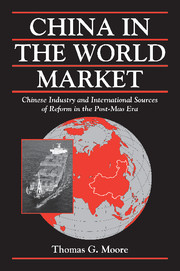Book contents
- Frontmatter
- Contents
- List of Figures
- List of Abbreviations
- Preface
- 1 China as a Latecomer in World Industrial Markets
- 2 The Outside World as an Impetus for Change in China
- 3 Tailor to the World: China's Emergence as a Global Power in Textiles
- 4 Beating the System with Industrial Restructuring: China's Response to the Multifiber Arrangement (MFA)
- 5 China Looms Large: Reform and Rationalization in the Textile Industry
- 6 Industrial Change in the Shadow of the MFA: The Role of Top-Level Strategy, Mid-Level Intervention, and Low-Level Demand in China's Textile Industry
- 7 Chinese Shipbuilding: The Modest Origins of an Emerging Industrial Giant
- 8 Dangerous Currents: Navigating Boom and Bust Cycles in International Shipbuilding
- 9 Chinese Shipbuilding and Global Surplus Capacity: Making a Virtue out of Necessity
- 10 Market-Oriented Solutions for Industrial Adjustment: The Changing Pattern of State Intervention in Chinese Shipbuilding
- 11 Who Did What to Whom?: Making Sense of the Reform Process in China's Shipbuilding Industry
- 12 External Shocks, State Capacity, and National Responses for Economic Adjustment: Explaining Industrial Change in China
- 13 China in the Contemporary International Political Economy
- Appendix Contours of the Research Effort
- Bibliography
- Index
12 - External Shocks, State Capacity, and National Responses for Economic Adjustment: Explaining Industrial Change in China
Published online by Cambridge University Press: 07 August 2009
- Frontmatter
- Contents
- List of Figures
- List of Abbreviations
- Preface
- 1 China as a Latecomer in World Industrial Markets
- 2 The Outside World as an Impetus for Change in China
- 3 Tailor to the World: China's Emergence as a Global Power in Textiles
- 4 Beating the System with Industrial Restructuring: China's Response to the Multifiber Arrangement (MFA)
- 5 China Looms Large: Reform and Rationalization in the Textile Industry
- 6 Industrial Change in the Shadow of the MFA: The Role of Top-Level Strategy, Mid-Level Intervention, and Low-Level Demand in China's Textile Industry
- 7 Chinese Shipbuilding: The Modest Origins of an Emerging Industrial Giant
- 8 Dangerous Currents: Navigating Boom and Bust Cycles in International Shipbuilding
- 9 Chinese Shipbuilding and Global Surplus Capacity: Making a Virtue out of Necessity
- 10 Market-Oriented Solutions for Industrial Adjustment: The Changing Pattern of State Intervention in Chinese Shipbuilding
- 11 Who Did What to Whom?: Making Sense of the Reform Process in China's Shipbuilding Industry
- 12 External Shocks, State Capacity, and National Responses for Economic Adjustment: Explaining Industrial Change in China
- 13 China in the Contemporary International Political Economy
- Appendix Contours of the Research Effort
- Bibliography
- Index
Summary
DOMESTIC STRUCTURE AS A SOURCE OF CHINESE POLICY MAKING
What explains the path taken in China to cope with the challenges presented by the MFA in textiles and GSC in shipbuilding? In an effort to construct an explanation that incorporates both the structuring impact of external forces and the mediating influence of internal forces, this chapter will rely heavily on the concept of state capacity, drawing upon the rich body of work developed by scholars in fields as diverse as comparative politics, foreign policy studies, and international political economy. Specifically, three critical aspects of domestic structure are identified from the case studies – the organizational structure of the state, the nature of government-industry relations, and the transitional nature of China's economy during the 1980s and early 1990s – to show a policy “fit” between the particular challenges posed by the outside world and the relatively market-oriented solution for industrial adjustment that emerged in the Chinese textile and shipbuilding industries. In keeping with the book's main theme, Chapter 2 focused conceptually on the catalytic role of the outside world, paying only passing attention to the mediating (but vital) role of domestic structure. Drawing on the case-study material, this chapter attempts to redress that imbalance by examining in detail how the specific capacities of the Chinese state shaped the range of adjustment strategies available in responding to the MFA in textiles and GSC in shipbuilding.
- Type
- Chapter
- Information
- China in the World MarketChinese Industry and International Sources of Reform in the Post-Mao Era, pp. 276 - 294Publisher: Cambridge University PressPrint publication year: 2002



